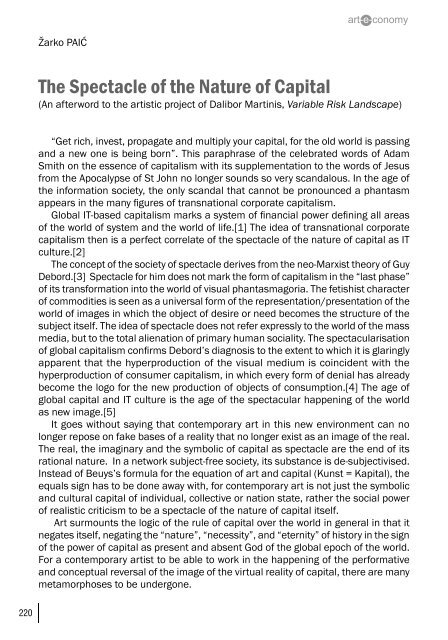art-e-conomy _ reader - marko stamenkovic
art-e-conomy _ reader - marko stamenkovic
art-e-conomy _ reader - marko stamenkovic
Create successful ePaper yourself
Turn your PDF publications into a flip-book with our unique Google optimized e-Paper software.
220<br />
Žarko PAIĆ<br />
The Spectacle of the Nature of Capital<br />
(An afterword to the <strong>art</strong>istic project of Dalibor M<strong>art</strong>inis, Variable Risk Landscape)<br />
“Get rich, invest, propagate and multiply your capital, for the old world is passing<br />
and a new one is being born”. This paraphrase of the celebrated words of Adam<br />
Smith on the essence of capitalism with its supplementation to the words of Jesus<br />
from the Apocalypse of St John no longer sounds so very scandalous. In the age of<br />
the information society, the only scandal that cannot be pronounced a phantasm<br />
appears in the many figures of transnational corporate capitalism.<br />
Global IT-based capitalism marks a system of financial power defining all areas<br />
of the world of system and the world of life.[1] The idea of transnational corporate<br />
capitalism then is a perfect correlate of the spectacle of the nature of capital as IT<br />
culture.[2]<br />
The concept of the society of spectacle derives from the neo-Marxist theory of Guy<br />
Debord.[3] Spectacle for him does not mark the form of capitalism in the “last phase”<br />
of its transformation into the world of visual phantasmagoria. The fetishist character<br />
of commodities is seen as a universal form of the representation/presentation of the<br />
world of images in which the object of desire or need becomes the structure of the<br />
subject itself. The idea of spectacle does not refer expressly to the world of the mass<br />
media, but to the total alienation of primary human sociality. The spectacularisation<br />
of global capitalism confirms Debord’s diagnosis to the extent to which it is glaringly<br />
apparent that the hyperproduction of the visual medium is coincident with the<br />
hyperproduction of consumer capitalism, in which every form of denial has already<br />
become the logo for the new production of objects of consumption.[4] The age of<br />
global capital and IT culture is the age of the spectacular happening of the world<br />
as new image.[5]<br />
It goes without saying that contemporary <strong>art</strong> in this new environment can no<br />
longer repose on fake bases of a reality that no longer exist as an image of the real.<br />
The real, the imaginary and the symbolic of capital as spectacle are the end of its<br />
rational nature. In a network subject-free society, its substance is de-subjectivised.<br />
Instead of Beuys’s formula for the equation of <strong>art</strong> and capital (Kunst = Kapital), the<br />
equals sign has to be done away with, for contemporary <strong>art</strong> is not just the symbolic<br />
and cultural capital of individual, collective or nation state, rather the social power<br />
of realistic criticism to be a spectacle of the nature of capital itself.<br />
Art surmounts the logic of the rule of capital over the world in general in that it<br />
negates itself, negating the “nature”, “necessity”, and “eternity” of history in the sign<br />
of the power of capital as present and absent God of the global epoch of the world.<br />
For a contemporary <strong>art</strong>ist to be able to work in the happening of the performative<br />
and conceptual reversal of the image of the virtual reality of capital, there are many<br />
metamorphoses to be undergone.


